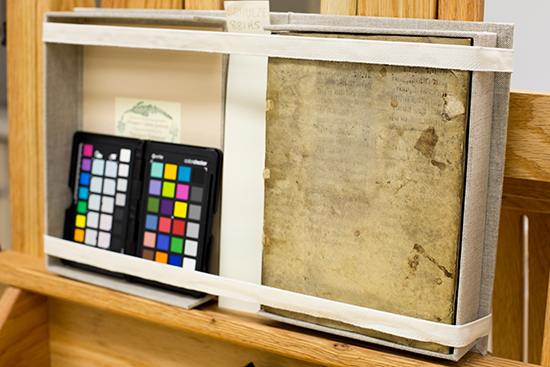Reading the Object Biography of a Reused Medieval Parchment
By combining spectroscopic imaging technologies, researchers identified the source of a parchment reused in a later binding
Between the 15th and 18th centuries, it was a known practice for bookbinders to reuse medieval parchments as binding materials for printed books. While scholars have long been aware that books from this period often contain hidden fragments of earlier manuscripts, the recent development of chemical imaging techniques offers the possibility of examining these bindings and reused materials safely—that is, with minimal handling of the fragile materials. By combining multiple imaging techniques—including visible hyperspectral imaging (HSI) and macro x-ray fluorescence (MA-XRF), as well as signal processing technologies—researchers were able to identify the source of reused medieval parchments and to learn more about the material history of books and manuscripts.
 Researchers worked with librarians at Charles Deering McCormick Library of Special Collections at Northwestern University to select an edition of Hesiod’s Work and Days printed in Venice in 1537. Purchased by Northwestern in 1870, the copy is the only remaining imprint retaining its original slotted parchment binding, a technique that was employed in the reuse of parchments.
Researchers worked with librarians at Charles Deering McCormick Library of Special Collections at Northwestern University to select an edition of Hesiod’s Work and Days printed in Venice in 1537. Purchased by Northwestern in 1870, the copy is the only remaining imprint retaining its original slotted parchment binding, a technique that was employed in the reuse of parchments.
Preparation of these reused parchments often involved washing or scraping ink from the sections that would be visible, while leaving the text untouched in portions that might be folded, glued over, or otherwise hidden in the new binding. Written areas were visible, but the iron gall ink inscribed on the older parchment had oxidized and deteriorated, leaving areas that were visible as writing, but it was impossible to distinguish individual words or letters.
Visible hyperspectral imaging (HSI) has proven successful at enhancing the hidden and damaged writing in other historical documents. The elemental maps created by the x-ray fluorescence (XRF) scans provide complementary information on the elemental composition of the different inks and pigments.
Combining—or fusing—these imaging and spectroscopic methods allows for enhancing the information from these scans, using synchrotron macro X-ray fluorescence (MA-XRF-SR) and signal processing methods to produce high-density images with enhanced spatial resolution.
The analytical techniques allowed researchers and librarians to read the hidden text, revealing passages from the Institutes Justinian, a 6th century A.D codification of Roman Law, with further marginal comments on medieval Canon Law. This identification opens up possibilities for further study about where and how these reused manuscripts may have been sourced for the bookbinding. The research can help cultural heritage institutions make informed decisions about conservation.
Publication:
Pouyet, E., S. Devine, T. Grafakos, R. Kieckhefer, J. Salvant, L. Smieska, A. Woll, A. Katsaggelos, O. Cossairt, and M. Walton. 2017. "Revealing the Biography of a Hidden Medieval Manuscript Using Synchrotron and Conventional Imaging Techniques." Analytica Chimica Acta 982:20-30.
